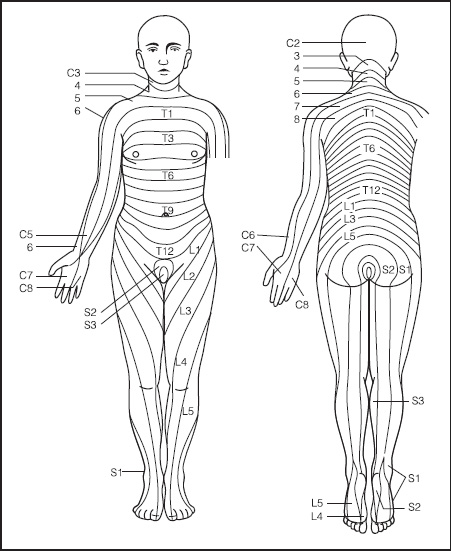The Therapeutic Conception of Dry Cupping
Dry Cupping as Segmental Therapy
Nature heals from the inside, with the assistance of external remedies.
Treatment at the site of the illness or at the reflex zones that correspond to the site of the illness, that is, at those skin areas that are connected to viscera via nerve tracts, is referred to as segmental therapy.
From time immemorial, almost all cultures have discovered and exploited in therapy the connections between viscera and the surface of the body. They used them to exert a healing effect on the deeper-lying organs, for example by applying warmth or cold or even by cupping. In the past, nobody knew why any of this was helpful. It simply was. It was most important to relieve complaints or achieve recovery. We are also very familiar with the influence of the skin on viscera. To reduce or eliminate pain, it is often enough to massage the corresponding skin areas lightly. The first discoveries in this field came from the Chinese. They recognized that it is possible to influence internal organs and pathologic complaints from certain points on the skin (acupuncture) or to surmise disease in certain organs on the basis of localized complaints.
“Head’s Zones”—Reflex Paths from Skin to Organ
More recently, the British neurologist Henry Head (1861–1940) also observed this phenomenon and discovered that reflex paths exist between the body’s surface (skin) and the viscera. He realized, for example, that patients with gallbladder disorders tend to be particularly sensitive to pain at the costal arches and at certain regions on the back. Kidney patients experience skin and muscle pain in the lower back on the affected side or frontally in the area around the bladder. Henry Head discovered that the painful and hypersensitive skin areas almost always lie on the same side of the body as the diseased organ. In addition, he observed that other diseases of viscera also resulted in elevated skin temperature or pain, but also disturbed blood circulation in the corresponding parts of the body’s surface (often far away from the affected organ). These suggest neural interactions between the viscera and the corresponding body surface.
Head’s research supplied the confirmation and therefore the scientific basis for the ancient experience of folk healing that the reflex connections from the body’s surface to the diseased organ can be utilized to have a curative effect on viscera. This has been corroborated by other researchers, such as Mackenzie (myogelosis), Vogler, Krauss (osteovisceral reflex paths), Preusser, Kötschau (gelosis), Hansen and von Staa (muscle reflexes), Pischinger, Kellner, Heine, Bergsam (processes in the vegetative nervous system), and others.
The investigations of Head and other well-known scientists finally explained and proved the way in which segmental cupping therapy and cupping diagnosis work. In segmental therapy, the skin plays the key role. It has specific relationships to the centers of the nervous system.
The skin surface is divided into segments, so to speak, corresponding to the entrance and exit levels of the individual spinal roots in the spinal cord.
The spinal fibers pair up into spinal nerves (spinal column nerves) on the right and left between two vertebrae where they exit from the spinal cord. Since they supply strip-shaped areas of the skin, segmentation arises, which are called segments or dermatomes. These dermatomes are highly important also for the segmental diagnosis of spinal cord damage.
In relation to the location where the nerves exit the spinal column, these segments are divided into: C = area of the cervical vertebrae, T = area of the thoracic vertebrae, L = area of the lumbar vertebrae, and S = area of the sacrum.
Every skin segment at the same time also has neural connections to certain viscera in the thoracic, abdominal, and sacral space. Biological functional circles (stimulatory circles) of the nervous system are in charge of the connections. These circles build a bridge between skin, central organs of the nervous system, and viscera. We now know these connections as so-called “cutivisceral/viscerocutaneous” reflex tracts (Fig. 3.1).
The diseased organ sends stimuli via the vegetative nerves to the corresponding skin areas, which can respond with tension, pressure points, swelling, atrophy of connective tissue, or chronic pain. These painful, hypersensitive, or changed skin areas are referred to as “Head’s zones.”

Fig. 3.1 Simplified illustration of the cutivisceral reflex paths.
| Each organ is represented in one zone: | ||
| Heart C3–T4 | → predominantly left | |
| Esophagus T4–T6 | → left or right | |
| Lungs/bronchial tubes C3–T9 | → left or right | |
| Stomach T8–T9 | → predominantly left | |
| Small intestine C3–T10 | → right or left | |
| Large intestine C3–T11 | → right or left | |
| Liver/gallbladder T8–T11 | → right | |
| Pancreas T7–T10 | → left | |
| Spleen T11 | → left | |
| Kidneys/ureter T8–S4 | → left or right | |
| Bladder on both sides T10–S4 | → left or right | |
| Uterus/ovaries and testicles T10–L3 | → left or right |
Head’s zones are of practical significance for segmental therapy and diagnosis (Fig. 3.2).

Fig. 3.2 Orienting illustration of the segments.
Segment reactions almost always occur on the same side of the body as the diseased organ. Nevertheless, segments can also overlap, or the disease symptoms can, in longer-lasting illness, jump from one segment to another.
Stay updated, free articles. Join our Telegram channel

Full access? Get Clinical Tree






